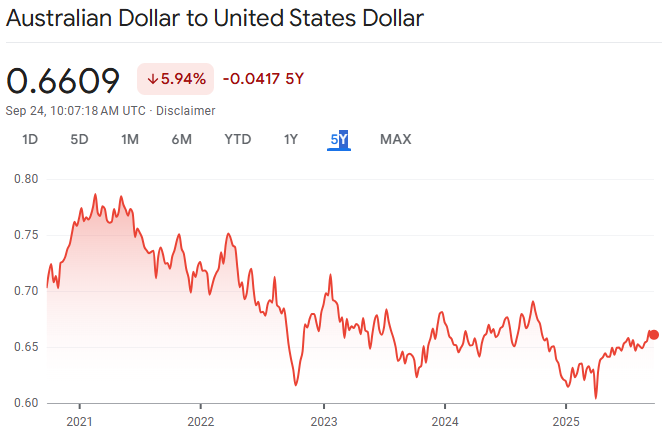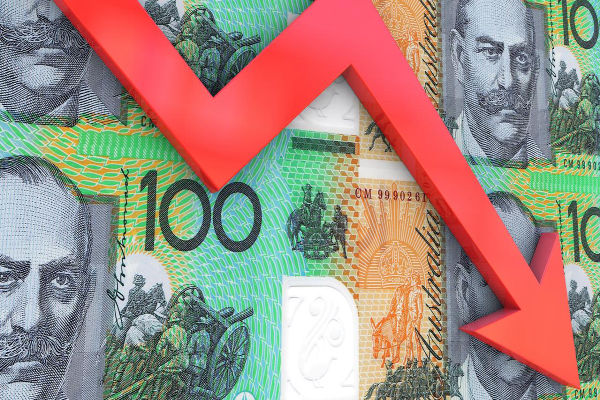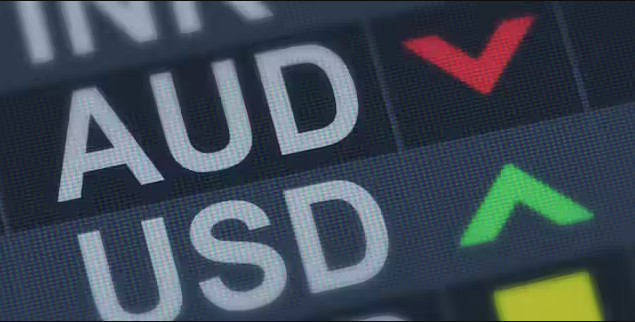The Australian dollar (AUD) has long been seen as a "commodity currency" tied to the nation's vast resource exports and global risk sentiment.

Yet in 2025, the Aussie has struggled to regain its former strength, trading around US$0.66 as of September 2025, well below its pre-2020 averages.
So, what's driving the weakness? The story is more complex than just "commodity prices down." Let's explore the complete reasons together below.
Why Is the Australian Dollar So Weak in 2025?

1. Interest Rate Differentials: RBA vs FED
After the RBA cut its cash rate to 3.85% on 20 May 2025, the Fed's 25-bp cut on 17 Sept 2025 left the U.S. funds rate at 4.00–4.25%. [1]
However, U.S. real yields remain relatively higher, keeping the dollar attractive to global investors. The market also anticipates further RBA cuts if growth weakens further, posing another downside risk for AUD.
2. Commodity Exports and the Energy Transition
Treasury modelling cited by The Guardian shows fossil-fuel export values could fall sharply under transition scenarios. [2]
In some projections, coal and gas export receipts are expected to drop by around 50% within the next five to ten years under a rapid transition scenario. This elevated tail risk weighs on AUD via the terms-of-trade channel.
3. China's Slowdown and "Stimulus Fatigue"
China accounts for nearly one-third of Australia's export demand, from iron ore to LNG. While Beijing has announced stimulus measures in 2025, analysts warn of "stimulus fatigue". The property sector remains fragile, consumer demand is patchy, and industrial investment has softened.
Should China fail to maintain its growth momentum, Australia's export earnings and consequently the AUD will continue to experience pressure.
4. Global Monetary and Trade Pressures
The RBA has flagged that trade patterns are shifting due to U.S.–China tensions and tariff adjustments. For example, a 10% baseline U.S. tariff on many imports was applied in 2025; Australia currently faces a 10% baseline tariff on many products.
These changes, along with a more robust U.S. dollar influenced by safe-haven demand during periods of global instability, have significantly impacted AUD performance. [3]
5. Domestic Credit and Housing Market Stress
Australia's housing market, previously a key source of household wealth, is now showing warning signs. Higher borrowing costs over 2023–2024 have left consumers stretched.
While RBA cuts may provide some relief, slowing credit growth and weaker domestic consumption reduce confidence in AUD's resilience.
6. Speculative Positioning and Market Sentiment
According to CFTC futures data, speculative traders have maintained a net short position in AUD through much of 2025, reflecting bearish sentiment on both commodities and Australia's growth prospects.
This speculative pressure amplifies downside moves when hedge funds pile into short AUD trades, volatility rises, and the currency struggles to bounce.
7. Terms of Trade and Structural Shifts
Beyond cyclical factors, Australia's structural challenges also matter:
Energy transition away from fossil fuels.
Global competition in critical minerals.
Possible over-reliance on one major trading partner (China).
These long-term shifts may reduce demand for AUD even if short-term rebounds occur.
Why AUD Might Not Keep Falling?

It's not all bearish. Several counterweights provide potential support:
Boom in critical minerals: The need for lithium and rare earth elements may counterbalance reductions in fossil fuels.
Policy support: The Australian government's fiscal spending and the RBA easing could stabilise growth.
Chinese rebound potential: If Beijing's stimulus gains traction, AUD could benefit sharply.
Carry trade demand: Even with lower rates, AUD yields remain higher than some peers, making it attractive in selective environments.
Frequently Asked Questions
1. Why Is the AUD So Weak in 2025?
Weaker commodity demand, RBA rate cuts, China's slowdown, and stronger USD flows.
2. Will the AUD Recover in 2026?
Yes. However, it depends on China's growth, global risk appetite, and the weakness of the U.S. dollar.
3. What Factors Most Affect AUD Strength?
Interest rate differentials, commodity prices, Chinese demand, and global market sentiment.
4. What Is the Fair Value for AUD/USD?
Many common fair-value frameworks (PPP / REER / medium-term model estimates) place AUD fair value in the ~0.68–0.70 range.
5. Is the RBA Done Cutting Rates?
Not necessarily. The RBA has hinted at further easing if inflation undershoots or growth falters.
Conclusion
In conclusion, the Australian dollar's weakness in 2025 derives from a combination of slowing exports, shifting trade patterns, monetary policy divergence, and uncertainties in China.
But the story isn't purely bearish. Structural demand for critical minerals, possible Chinese recovery, and global shifts in monetary policy could provide a floor and even a rebound in the years ahead.
Disclaimer: This material is for general information purposes only and is not intended as (and should not be considered to be) financial, investment or other advice on which reliance should be placed. No opinion given in the material constitutes a recommendation by EBC or the author that any particular investment, security, transaction or investment strategy is suitable for any specific person.
Sources
[1] https://www.reuters.com/sustainability/sustainable-finance-reporting/australias-central-bank-cuts-rates-2-year-low-385-2025-05-20/
[2] https://www.theguardian.com/business/2025/sep/20/australias-fossil-fuel-earnings-set-to-fall-by-50bn-a-year-by-2035
[3] https://www.rba.gov.au/publications/smp/2025/may/box-a-how-might-tariffs-affect-australian-trade.html
























